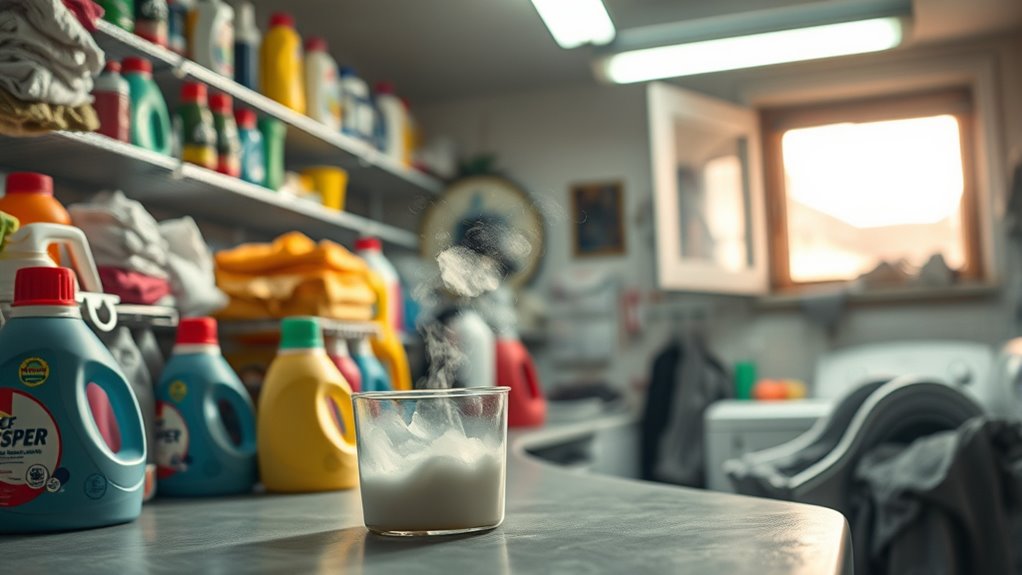Laundry detergents and softeners release chemical fumes that can quickly pollute your indoor air. When you wash clothes, these VOCs evaporate and linger long after, potentially causing respiratory issues, headaches, or allergies. Ventilation helps reduce fumes, but choosing eco-friendly products and storing chemicals properly can make a big difference. If you want to find ways to improve your home’s air quality, discover more tips you can try today.
Key Takeaways
- Detergent fumes release VOCs that can linger in the air, contributing to indoor air pollution.
- Inhalation of chemical vapors from laundry products may cause respiratory irritation and headaches.
- Prolonged exposure to detergent fumes can affect lung health and immune function.
- Poor ventilation in laundry rooms allows fumes to spread throughout the home, reducing air quality.
- Using eco-friendly, fragrance-free products and proper ventilation reduces detergent fume buildup indoors.

Have you ever considered that your laundry room might be a hidden source of pollution? Many people don’t realize that the air quality inside their homes can be substantially affected by what happens in this often-overlooked space. When you run your washing machine or dryer, fumes from detergents, fabric softeners, and stain removers can release volatile organic compounds (VOCs) into the air. These chemical fumes aren’t just confined to the laundry room; they can spread throughout your home, impacting your overall indoor air quality. Prolonged exposure to these chemicals can lead to health issues like respiratory irritation, headaches, or allergic reactions, especially for those with sensitivities or asthma.
Your laundry room may silently impact your home’s air quality and health.
The primary concern is chemical exposure. Laundry detergents and related products are formulated with various chemicals designed to clean and freshen fabrics, but many contain substances that evaporate into the air during use. These fumes can linger long after the laundry is done, creating a persistent source of indoor pollution. You might not notice the immediate effects, but over time, your lungs and immune system can suffer from repeated inhalation of these chemical vapors. Children, pets, and allergy sufferers are especially vulnerable because they tend to spend more time in the home and have weaker immune defenses.
Reducing chemical exposure starts with awareness. First, check the labels of your laundry products and opt for those labeled as eco-friendly, fragrance-free, or free from harsh chemicals. These options typically emit fewer fumes, making them safer for your indoor air quality. Always use detergents in well-ventilated areas—open windows or turn on exhaust fans to help disperse fumes quickly. If possible, switch to natural alternatives like baking soda or vinegar for cleaning and deodorizing clothes, which don’t release harmful chemicals into the air.
Another effective measure is to upgrade your laundry space with better ventilation. Installing an exhaust fan or ensuring your laundry room has a window that opens can dramatically improve air circulation, preventing chemical fumes from building up. Regularly cleaning your dryer’s lint trap and vent can also help reduce fumes, as poor ventilation can trap chemicals inside the machine or room. Additionally, storing laundry products in sealed containers outside the laundry area can prevent accidental spills and limit chemical fumes from escaping into your home.
Moreover, integrating AI-driven data analytics can help monitor and optimize indoor air quality by identifying sources of pollutants and suggesting effective ventilation strategies.
Frequently Asked Questions
Can Laundry Detergents Cause Long-Term Health Issues?
You might wonder if laundry detergents can cause long-term health issues. Chemical exposure from strong detergents can impact your respiratory health over time, especially if you’re sensitive or regularly exposed. Some ingredients may irritate your lungs or trigger allergies, potentially leading to chronic issues. To protect yourself, choose natural or fragrance-free options and guarantee good ventilation during laundry to minimize chemical buildup and safeguard your long-term health.
Are There Natural or Eco-Friendly Detergent Options?
You might wonder if natural or eco-friendly detergents truly exist. The truth is, plant-based detergents and biodegradable options are readily available and effective. These alternatives use natural ingredients, reducing chemical fumes and environmental impact. Switching to these options can make your laundry safer and greener, proving that you don’t need harsh chemicals to get clean. Embrace plant-based and biodegradable detergents for a healthier home and planet.
How Can I Improve Ventilation in My Laundry Room?
To improve ventilation in your laundry room, start by installing an exhaust fan to remove fumes and moisture effectively. You can also use an air purifier with a HEPA filter to trap airborne particles and improve air quality. Keep the door open when possible, and consider adding a window or vent. These steps help reduce detergent fumes and create a healthier environment inside your laundry space.
Do Dryer Vents Contribute to Indoor Air Pollution?
Did you know your dryer vent might be quietly affecting your indoor air quality? When your dryer vents outdoors, it usually helps reduce indoor pollution. But if the vent is blocked or poorly connected, it can cause lint and fumes to linger inside, increasing indoor pollution. Regularly cleaning and inspecting your dryer vent guarantees it works efficiently, keeping harmful fumes out and your indoor air safer.
Are There Specific Symptoms Linked to Detergent Fumes?
You might notice symptoms like sneezing, coughing, or itchy eyes after being exposed to detergent fumes. If you’re sensitive or have detergent allergies, these fumes can cause respiratory irritation, making it harder to breathe or causing a sore throat. You should pay attention to these reactions and consider switching to hypoallergenic detergents or improving ventilation in your laundry area to reduce exposure and protect your health.
Conclusion
Did you know that laundry room fumes can contain over 25 different airborne chemicals, many of which are linked to respiratory issues? By being mindful of the products you use and ensuring proper ventilation, you can considerably reduce your exposure to harmful fumes. Taking these simple steps not only improves your indoor air quality but also keeps your home healthier for you and your family. Protect your space — breathe easier today!









